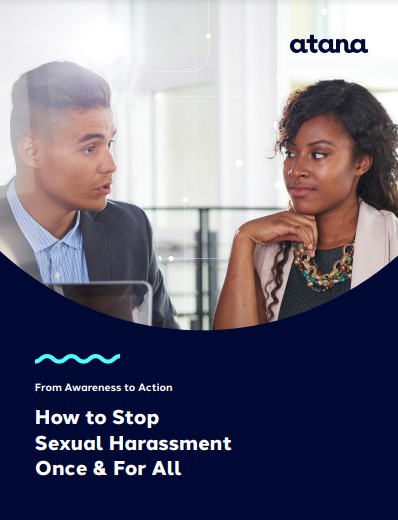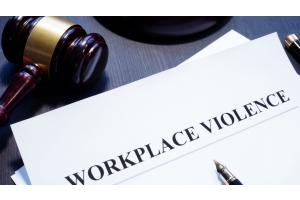
Sexual harassment is a form of discrimination that refers to illegal sexual conduct in the workplace. It may be experienced by employees of any gender, sexual orientation, gender identity, and gender expression.
According to the U.S. Equal Employment Opportunity Commission, sexual harassment is:
Unwelcome sexual advances, requests for sexual favors, and other verbal or physical conduct of a sexual nature constitute sexual harassment when this conduct explicitly or implicitly affects an individual's employment, unreasonably interferes with an individual's work performance, or creates an intimidating, hostile, or offensive work environment.
The U.S. Equal Employment Opportunity Commission (EEOC) is responsible for enforcing federal laws pertaining to various types of discrimination, including that which is based on sex (including gender identity and and sexual orientation). Sexual harassment is a form of sex discrimination that violates Title VII of the Civil Rights Act of 1964.
Title VII pertains to organizations that employ 15 or more people, as well as federal, state, and local governments; employment agencies; and labor organizations. In addition, many states have sexual harassment prevention laws that pertain to the private sector, including organizations that employ fewer than 15 workers.
Sexual harassment can occur in a variety of circumstances:
- The victim and harasser may be any sex, and the victim and harasser may be the same or different sexes.
- The harasser may be the victim’s co-worker, supervisor, a supervisor in another area of the organization, an agent of the employer, or a non-employee (3rd party sexual harassment).
- The victim may be the person harassed, but could also be “anyone affected by the offensive conduct” (indirect sexual harassment).
Sexual harassment may or may not cause economic injury or the victim’s discharge by the employer.
What are the two types of Sexual Harassment?
1. Hostile Work Environment
- Occurs when unwelcome comments or conduct based on sex unreasonably interfere with work performance or create an intimidating, hostile, or offensive work environment.
- Can be unwelcome and offensive written/visual, verbal, non-verbal or physical conduct.
- Can be either a pattern that is severe or pervasive or a one-time severe and egregious act. In some states and Washington DC, the pattern of behavior doesn’t need to be pervasive to be considered sexual harassment.
Hostile Work Environment has two sub-categories:
- Third Party Hostile Work Environment - Occurs when a non-employee creates an intimidating, hostile, and offensive work environment for an employee.
- Non-employees can include customers, vendors, distributors, and contractors.
- Indirect Hostile Work Environment - Occurs when an individual is negatively impacted by sexual conduct that does not happen directly to them.
- For example, an employee can experience an offensive, hostile work environment based on sexual conduct that targets a co-worker.
2. Quid Pro Quo
- Occurs when an individual in authority requests sex, sexual favors, or a sexual relationship.
- Acceptance or rejection of the request can impact the victimized employee’s job, resulting in a tangible employment action (e.g., job perks, desirable work, promotion, undesirable work, demotion, and termination).
- Can be either a direct or implied "this-for-that" element.
What are the Effects of Sexual Harassment in the Workplace?
When sexual harassment occurs at work, the harm done can reach far beyond the individuals immediately involved
- Effects on the Victim: Psychological/Emotional Impact (anxiety, depression, fear, low self-esteem); Physical Impact (muscle aches, headaches, high blood pressure, digestive problems); Financial Impact if employee leaves due to harassment (loss of income, negative impact on earning potential and career trajectory); Potential negative impact on reputation
- Effects on the Organization: Low employee morale/productivity; Financial impact; Loss of reputation
- Effects on Witnesses: Low morale/productivity; Shame for not speaking up; Stress
- Effects on the Accused Harasser: Loss of job/career; Loss of reputation; Financial Impact; Stress; Impact on Personal Relationships
With so much at risk, effective prevention of sexual harassment in the workplace is vital to the health and survival of organizations and their workforces.
Why is Sexual Harassment at Work a Continuing Challenge?
Despite efforts like the #MeToo movement, and media coverage of sexual harassment, these behaviors still happen often in the workplace.
Why is it so difficult to prevent sexual harassment? Contributing factors include societal attitudes and beliefs, workplace systems and structures, training content and design, and individual employee behavior
6 Roadblocks to Preventing Sexual Harassment
In its ebook, From Awareness to Action: How to Stop Sexual Harassment Once & For All, Atana describes six roadblocks it says are “getting in the way of solving the issue.”
1. Fear
Victims of sexual harassment may choose not to report incidents out of fear that speaking up will cost them their jobs (and income). They may think they won’t be believed, that their reports won’t be acted upon, or that they’ll be blamed for harassment. Some also fear retaliation by the harasser.
Fear can paralyze witnesses to sexual harassment, too. Concerns about retaliation can keep bystanders silent. Witnesses also may fail to act because they don’t see others speaking out. This can create fear that taking action is not an appropriate response in the context or culture of their organization.
2. Poor Organizational Policies
Responsibility for creating sexual harassment prevention policies is usually up to business organizations in which problems occur, formal and effective policies against harassment may be lacking. This can leave employees unsure about what constitutes sexual harassment and what to do about incidents when they occur. Ineffective policies also undercut victims’ abilities to take action and gain restitution.
3. Training Costs and Logistics
Company leaders may refuse to insist on quality sexual harassment prevention training for their workforces due to implementation costs. This failure to act can put the organization at risk for millions of dollars in fines and legal judgments because of harassment-provoked litigation.
4. Prevention Training Fails to Drive Behavior Change
Many learning and development professionals agree that prevention education has fallen short in positively shifting employee behaviors. Often the content fails to engage audiences and doesn’t present material that is relevant or practical. Even professionals who express satisfaction with training products often report poor results because training isn’t followed-up and reinforced systematically.
5. Employees Resist Prevention Training
Research by Atana found that employee resistance is the leading challenge underlying sexual harassment prevention training. Differing personal perspective and discomfort in addressing sexual harassment may cloud employees’ views about prevention training. This ultimately makes them resistant to educational efforts and requires employers to take significant actions to change mindsets.
6. Confusion about Compliance
When sexual harassment prevention training is required by government entities, confusion is a frequent result. With an increasing number of states taking action to mandate training, business leaders may be challenged to understand their legal obligations to provide appropriate training for their workforces.
Making the Business Case for Sexual Harassment Prevention
Making a business case for any organizational initiative relies on the ability to convince senior leaders that a genuine need exists—one that warrants the investment of people, time, and money. Metrics are the currency that demonstrates such needs, and may reflect conditions inside and outside an organization.
The type of information that will be relevant in making the business case varies by company size, industry, and other variables. The following measurements are among those likely to be most helpful to human resources (HR) and learning and development (L&D) professionals.
Bottom Line Results Impacted by Sexual Harassment Prevention
Effective prevention of sexual harassment in organizations both contributes to and reflects the presence of a respectful workplace culture, so there is significant crossover in the internal metrics used to support the business case for both initiatives. When it comes to sexual harassment prevention specifically, these are some important internal metrics to consider:
- Business Key Performance Indicators (KPIs)
- Sales/revenues
- Business costs
- Productivity levels
- Turnover and retention rates
- Employee engagement levels
- Talent acquisition measures
- Diversity, Equity, and Inclusion measures
- Legal costs to defend complaints, victim awards, and fines
- Changes in individual/team performance ratings
- Changes in customer satisfaction levels
- Employee behaviors and performance
- Employee engagement levels
- Changes in individual/team performance ratings
- Employee well-being measures
- Absenteeism rates
- 360-degree assessments
- Job satisfaction levels
- Net promoter scores
- Employee experience measures
- Supervisor/manager observations of learning applied on the job
Sources of Statistics on Sexual Harassment in the Workplace
For broader context and perspective, internal measures relevant to sexual harassment occurrence and prevention can be supplemented with data from credible external sources.
The U.S. Equal Employment Opportunity Commission (EEOC) tracks and publishes extensive data on charges, enforcement, and litigation.
The National Conference of State Legislatures (NCSL) offers information on sexual harassment and related training laws in the U.S and The Institute for Women’s Policy Research is another respected source of information.
The University of Maryland Global Campus Library offers a free online checklist to aid HR and learning professionals in identification of credible online information sources.
Trends in Offering Sexual Harassment Prevention Training
Almost three quarters of organizations offer sexual harassment prevention training. That research revealed that just over 75% of employers that offered harassment prevention training required all employees to participate.
Among companies that do provide training, 57% turn to their HR functions to take the lead.
In the U.S., most states now recommend or encourage employers to provide training on prevention of sexual harassment in the workplace. These states (and cities) require prevention training: CA, CT, DE, IL, ME, NY, TX, WA and Chicago. For more information on these regional mandates see Atana's Sexual Harassment Training Compliance Guide and Requirements Matrix.
How to Measure the Effectiveness of Sexual Harassment Training
Key metrics related to sexual harassment prevention training might include:
- Return on investment in training
- Number of training completions
- Evaluation of training by participants
- Feedback/observation by managers of training participants’ behaviors
- Application of concepts learned
- Participation in follow-up interventions to sustain learning
- Impact on business and employee behavior metrics
These metrics can come through using an approach like the Kirkpatrick Evaluation Model. It is a four-level framework that encompasses how learners react to training, skills/knowledge gained, behavior/performance change, and business results. Data captured and reported by content vendors can provide relevant insights, too
7 Key Benefits of Sexual Harassment Training
Prevention is the best tool to eliminate sexual harassment in the workplace. Employers are encouraged to take steps necessary to prevent sexual harassment from occurring. They should clearly communicate to employees that sexual harassment will not be tolerated. They can do so by providing sexual harassment training to their employees and by establishing an effective complaint or grievance process and taking immediate and appropriate action when an employee complains.
—U.S. Equal Employment Opportunity Commission
When organizations deliver effective sexual harassment prevention training, they are actively leveraging a core element in what the EEOC calls “the best tool to eliminate sexual harassment in the workplace” – prevention.
Successful sexual harassment prevention training has the potential to drive far-reaching positive effects for organizations and their workforces, alike.
Prevention training heightens awareness of behaviors, calling attention to what is and isn’t appropriate in the workplace. Effective sexual harassment prevention training delivered to all employees in an organization helps ensure consistent understanding of the actions that constitute harassment, educates individuals about their legal rights, and emphasizes personal empowerment, which equips bystanders to stand up for victimized co-workers.
Surfacing those benefits for an organization adds support to the business case for providing sexual harassment prevention training. Further, identifying the potential risks that individuals and organizations face when sexual harassment prevention fails or is ignored, helps to quantify and highlight the true costs that may arise when workplaces lack commitments to respect and personal safety.
Many research studies highlight the benefits of sexual harassment prevention training and the risks/costs of prevention failure. Some points to consider:
1. Stronger Organizational Culture
Harassment prevention training, whether live or virtual, offers opportunities to talk about and reinforce company values and culture. Purpose-centered cultures, such as those focused on respect, bring people together to work toward common goals.
Risk/cost avoided: In looking at costs of harassment, a U.S. government study found that only about a third of employees who’d experienced—or even observed—more than one instance of sexual harassment in their workplaces said they were satisfied with or approved of their organizations’ cultures. Almost six in 10 expressed satisfaction with cultures in organizations where no sexual harassment had been experienced or observed.
2. Improved Talent Retention
Lower turnover is far more likely to occur in organizations where employees don’t feel at risk simply by being in the workplace.
Risk/cost avoided: Studies have found that victims of sexual harassment are 6.5 times more likely than other workers to change jobs within two years. Further, 70% of those who sought legal help because of sexual harassment reported job loss as the most common form of retaliation. Latest estimates put the cost of just recruiting, hiring, and onboarding a new employee (which can take six months or longer, on average) at up to $4,425 per person.
3. Reduced Absenteeism
Eradicating sexual harassment in workplaces (and the attendant mental and physical health issues harassment causes) can help organizations improve attendance.
4. Enhanced Productivity and Performance
Loss of individual productivity, which contributes directly to loss of overall organizational output and performance, is a leading result of sexual harassment in the workplace. Consequently, successful prevention of that harassment is seen as a top strategy for improving both employee and enterprise performance.
Risk/cost avoided: Decreased productivity is the single most likely result of sexual harassment at work, according to researchers who found that more than one in five victims (22%) said their productivity declined in the aftermath of a harassment incident. One study put the yearly cost of lost productivity due to sexual harassment at $2.62 billion.
5. Higher Employee Engagement and Job Satisfaction Levels
When employees are free from worry about their personal safety at work, including having the belief that that they are protected from being sexually harassed, they report significantly greater satisfaction with their work and higher levels of engagement on the job..
Risk/cost avoided: Only about half of employees who saw or experienced sexual harassment on the job reported feeling inspired to do their best work (compared with more than seven in 10 of those who didn’t have those experiences). More than 60% of employees who’d witnessed or been victims of harassment expressed dissatisfaction with their levels of stress at work.
6. Higher Levels of Well-Being
Since the pandemic, organizations have upped focus on and commitment to employee well-being, especially mental health. Ensuring that workplaces are free from sexual harassment is an important contributor to both physical and mental well-being. In turn, greater levels of employee well-being drive better organizational performance.
Risk/cost avoided: Sexual harassment at work can lead to depression, post-traumatic stress disorder, other mental health issues and higher risks of long-term wellness issues for victims. Further, those who lose their jobs because of harassment are also likely to lose healthcare insurance, forcing many to forego needed therapy or other care.
7. Legal Compliance and Protection from Litigation
Financial and time savings can be enormous when companies avoid investigations, fines, legal fees, expensive settlements, and awards for victims.
Risk/cost avoided: In 2021, alone, the EEOC collected $61.6 million from employers for sexual harassment claims. Because the organization litigates only a small number of the harassment charges it receives, that figure represents only a small portion of potential employer cost risk. Victims of harassment suffer financially, too. Researchers note job loss and unemployment due to sexual harassment can cost women in high-end professions millions of dollars; and even costs for those in low-paying jobs can exceed $100,000. .
More information on benefits of sexual harassment prevention training (and the costs of not training) is available in Atana’s ebook, From Awareness to Action: How to Stop Sexual Harassment Once & For All.
Lasting Sexual Harassment Prevention: Focus on Culture Not Compliance
Compliance with state and other mandates for sexual harassment prevention training is necessary, but training done only to meet legal requirements is unlikely to achieve meaningful behavior change and reinforce the kind of organizational culture in which sexual harassment is not tolerated. Achieving lasting success in sexual harassment prevention demands more.
Remarks by past EEOC Commissioner Victoria Lipnic underscore the effectiveness of the approach designed by Atana that integrates sexual harassment prevention training for employees and managers into the broader idea of a respectful workplace:
"Training needs to explore civility in general and how to have a respectful workplace. It shouldn't just focus on workers who experience harassment themselves. It needs to empower bystanders to speak up when they witness harassment and teach them how to intervene.
Additionally, managers need to have the tools to respond to situations when they arise. If the front-line supervisors don't know how to respond when a worker complains about something another employee said or did, ‘things can go off the rails pretty quickly.’"
The idea of organizational culture as the basis for a commitment to prevention of sexual harassment is particularly important in the wake of the dramatic shifts in employee work locations driven by the COVID-19 pandemic. Some industries and jobs can’t operate remotely, so many workers never left enterprise facilities. Others migrated to home offices. Further, many companies are returning to workplaces and considering, or are already moving toward, hybrid work models in which employees split time between remote and on-site work settings.
Regardless of employees’ work locations, culture is a constant, and its health—and focus on respect—must be maintained. That means that the need for training that emphasizes a culture of respect, including sexual harassment prevention training, remains just as strong going forward as it was in the pre-pandemic business world.
The Consequences of Ineffective Sexual Harassment Prevention Training
For many organizations, implementation of prevention training hasn’t solved the problem of sexual harassment in the workplace.
Writing in Harvard Business Review (HBR), sociology professors and researchers Frank Dobbin of Harvard and Alexandra Kalev of Tel Aviv University confirm that, in 2020, 40% of women and 16% of men still said they’d been sexually harassed at work. In the wake of #MeToo and despite “widespread grievance procedures and forbidden-behavior training,” harassment continues.
In fact, harassment research by Dobbin and Kalev found that many existing training approaches, along with organizational grievance procedures, were compounding the problem and increasing employee dissatisfaction and attrition. Further, they say that training that centers on forbidden behaviors in the workplace negatively affects the numbers of women in management and actually creates a backlash that results in men being “more likely to blame the victims and to think that women who report harassment are making it up or overreacting.”
The American Psychological Association (APA) agrees that ineffective training can exacerbate harassment problems, noting that many organizations resist training or just do so to satisfy mandates: “Conducting a one-time training for new employees is ineffective and is usually just window dressing by companies seeking protection from lawsuits.”
Sexual Harassment Training Activities That Work
Although many past efforts at sexual harassment prevention training haven’t produced the desired results, experts, including Dobbin, Kalev, and other experts cited by the APA, point to several best practices that characterize effective prevention training.
- Turn Bystanders into Upstanders. Bystander Intervention training “may help increase a sense of accountability, where employees are expected to speak up and even file their own complaints when they witness sexual harassment involving another employee,” observes the APA.
Dobbin and Kalev call bystander training “the most promising alternative we’ve come across,” and report its use by the U.S. Air Force. In addition, inclusion of bystander training has been mandated by the city of New York for its employee harassment training.
- Provide Manager-Specific Training. “Companies that adopted distinct manager-training programs saw significant gains in the percentage of women in their managerial ranks,” say Dobbin and Kalev, adding that the approach is particularly effective because it emphasizes the fact that sexual harassment is a problem that every manager must handle.
Targeted training teaches managers to recognize the early signs of harassment and how to quickly and constructively intervene so the problem doesn’t escalate. Dobbin and Kalev’s research found men more likely to respond to manager-specific training, in part, because male participants feel “they’re being given new tools that will help them solve problems they haven’t known how to handle in the past—and in part because they’re assumed to be potential heroes rather than villains.”
SHRM, the Society for Human Resource Management, also urges HR and L&D leaders to train managers separately, even though organizations may lean toward a unified approach. Why? “Managers have special responsibilities and need to be educated on these responsibilities in addition to the information provided to all employees.”
- Deliver Comprehensive and Engaging Training. Comprehensive encompasses “pre-training, training and post-training components at the individual and group levels,” according to the APA. Further, it recommends that training be interactive, and utilize multiple methodologies to engage employees.
33%
Studies show 1 out of every 3 employees says uninspiring content is a barrier to learning.
- Follow Through. An especially important key to success in sexual harassment prevention training involves avoiding the trap of a one-and-done attitude. The APA goes so far as to recommend that follow-up after initial training be reinforced through the use of knowledge assessments and refresher training on an annual basis.
3 Ways to Make Your Sexual Harassment Training More Impactful
For L&D and HR professionals seeking additional resources on topics that figure into sexual harassment prevention training outcomes, Atana suggests these assets:
- Overcoming employee resistance helps address a major impediment to effectiveness in sexual harassment prevention training. Among the tactics HR and L&D professionals apply are: attention to training design, ensuring engaging content and presentation, addressing learners’ specific objections, and more.
- Providing support for managers ensures that leaders on organizational frontlines are equipped with the skills they need to handle conversations about sexual harassment (and prevention training) constructively and to take fast, effective action when harassment incidents occur or complaints are made.
- Choosing effective training designs, that meet recommendations by the Society for Human Resource Management, involves considerations about internal branding and marketing of sexual harassment prevention training, encouraging interactivity, involving senior leaders, and other strategies. To learn more about SHRM suggestions, read: Sexual Harassment Prevention Training Should Involve Real Conversations .
In its From Awareness to Action: How to Stop Sexual Harassment Once & For All ebook, Atana explains how people at all organizational levels can heighten prevention training success.
Organizational Actions:
- Train everyone – deploying company-wide training has the potential to strengthen available defenses if the organization is subjected to legal action, helps ensure compliance, and supports stronger business and talent outcomes.
- Include training that targets both current and next-generation managers to ensure that prevention is a mindset established early in leadership careers.
Manager Actions:
- Lead by example should be a mandate not only for managers, but for leaders at all organizational levels. Role modeling is an especially effective reinforcer of learning for employees and encourages active and ongoing participation by leaders.
- Inspire bystanders to be upstanders by ensuring that employees are comfortable speaking up about harassment. Managers are ideally positioned to openly talk about harassment during meetings and work to destigmatize conversations about harassment.
- Take all reports of harassment seriously … and take action. Managers must listen attentively, avoid making judgements about employees, and take swift action to handle complaints according to prescribed procedures.
Employee Actions:
- Be open to sexual harassment prevention training. Employees can strengthen training success by embracing the idea that prevention training is an opportunity to become part of a positive organizational movement for change.
- Become self-aware. Workers can use sexual harassment prevention training to better understand the behaviors that constitute harassment, then apply their learning by intentionally monitoring and governing their own actions.
- Resolve to be an upstander. Applying the concepts learned in sexual harassment prevention training culminates in bystanders becoming upstanders. Employees who make it clear that they are committed to speaking up when they see harassment are critical contributors to effective prevention.
The Future of Sexual Harassment Prevention Training
Laws are a Good Start, But There's More to the Equation
Increasing legislation offers a key strategy to address workplace sexual harassment. And, the good news is that more and more states have followed (or will soon follow) in the trailblazing footsteps of California by passing laws to strengthen support for victims and to require sexual harassment prevention training in organizations.
But multiple sources affirm that compliance as the core driver of sexual harassment prevention training doesn’t produce effective results, and often worsens the problem. Consequently, it’s clear that laws are only part of the solution to achieving a future free of workplace sexual harassment.
Lasting Change will Only Come with a Shift in Culture
Achieving true and lasting behavior change organization-wide will require a seismic shift in corporate culture—in essence, a holistic approach that includes sexual harassment prevention, along with other critical elements, to create a workplace atmosphere where safety, inclusion, and regard for others are paramount.
Establishing and growing a culture of respect calls for broader educational initiatives—including comprehensive training in such topics as:
- Diversity, equity, and inclusion
- Minimizing the impact of bias, and eliminating bullying and harassment
- Workplace violence prevention and conflict resolution
- Leadership and management skills that build and sustain positive culture change
- Communication skills, accountability, and other behaviors that characterize safe, respectful workplaces
Sexual Harassment Prevention Training Can't be "One and Done"
In addition to establishing and growing cultures of respect, organizations can add the final, crucial element in eliminating sexual harassment in its workplaces—effective sexual harassment prevention training.
Experts on sexual harassment agree that the most effectual training:
- turns bystanders into upstanders who watch out for and support their co-workers
- is engaging and includes separate programming that specifically targets managers
- is ongoing—with regular updates and opportunities to refresh the initial learning
- includes follow up to ensure harassment prevention skills and knowledge are applied
These driving factors make it clear that the expertise and ownership of HR and L&D are critical to achieving lasting effectiveness in sexual harassment prevention training, now and going forward.
Recommended Training
Once & For All
Stopping Sexual Harassment at Work
Employee and Manager Courses
End inappropriate behavior and empower employees to stand up for respect with this uniquely designed eLearning that maximizes learner engagement and meets sexual harassment training requirements in all 50 states.


Atana Insights, our proprietary analytics engine, amplifies the impact of Once & For All by turning course engagement into data, data into insights, and insights into actionable next steps that improve key performance indicators directly tied to culture change and training ROI. Request a demo of our Atana Insights dashboard.
1https://www.eeoc.gov
2https://www.eeoc.gov/statutes/title-vii-civil-rights-act-1964
3https://www.eeoc.gov/statistics/enforcement-and-litigation-statistics
4https://www.gao.gov/assets/710/709862.pdf
5https://www.ncsl.org/research/labor-and-employment/sexual-harassment-in-the-workplace.aspx
6https://iwpr.org/iwpr-publications/briefing-paper/sexual-harassment-and-assault-at-work-understanding-the-costs/
7https://sites.umgc.edu/library/libhow/credibility.cfm
8 https://www.td.org/insights/71-percent-of-organizations-offer-sexual-harassment-prevention-training
9https://www.prnewswire.com/news-releases/the-top-three-learning-development-and-training-activities-in-which-hr-is-most-involved-are-sexual-harassment-prevention-training-antidiscrimination-training-and-onboarding-says-xperthr-survey-301103924.html
10https://www.mspb.gov/MSPBSEARCH/viewdocs.aspx?docnumber=1500639&version=1506232&application=ACROBAT
11https://www.usatoday.com/story/money/2017/10/25/sexual-harassment-here-some-biggest-cases/791439001/
12https://www.shrm.org/ResourcesAndTools/legal-and-compliance/employment-law/Pages/How-to-Revamp-Your-Harassment-Prevention-Program.aspx
13https://hbr.org/2020/05/why-sexual-harassment-programs-backfire
14https://journals.sagepub.com/doi/abs/10.1177/0021886301372001
16https://www.apa.org/monitor/2018/02/sexual-harassment
17https://www.shrm.org/resourcesandtools/hr-topics/behavioral-competencies/global-and-cultural-effectiveness/pages/sexual-harassment-prevention-training-should-involve-real-conversations.aspx
18https://www.shiftelearning.com/blog/statistics-on-corporate-training-and-what-they-mean-for-your-companys-future
19https://www.shrm.org/resourcesandtools/hr-topics/behavioral-competencies/global-and-cultural-effectiveness/pages/sexual-harassment-prevention-training-should-involve-real-conversations.aspx






